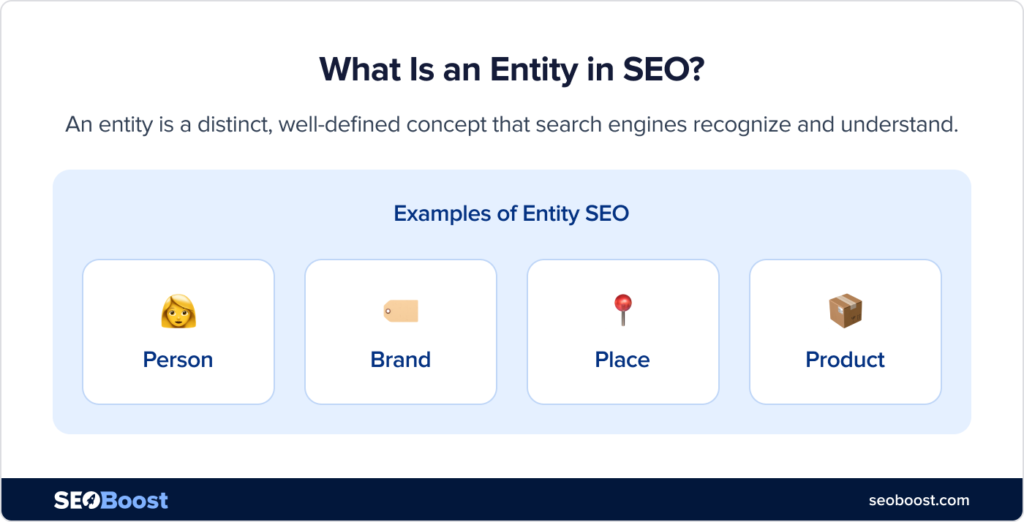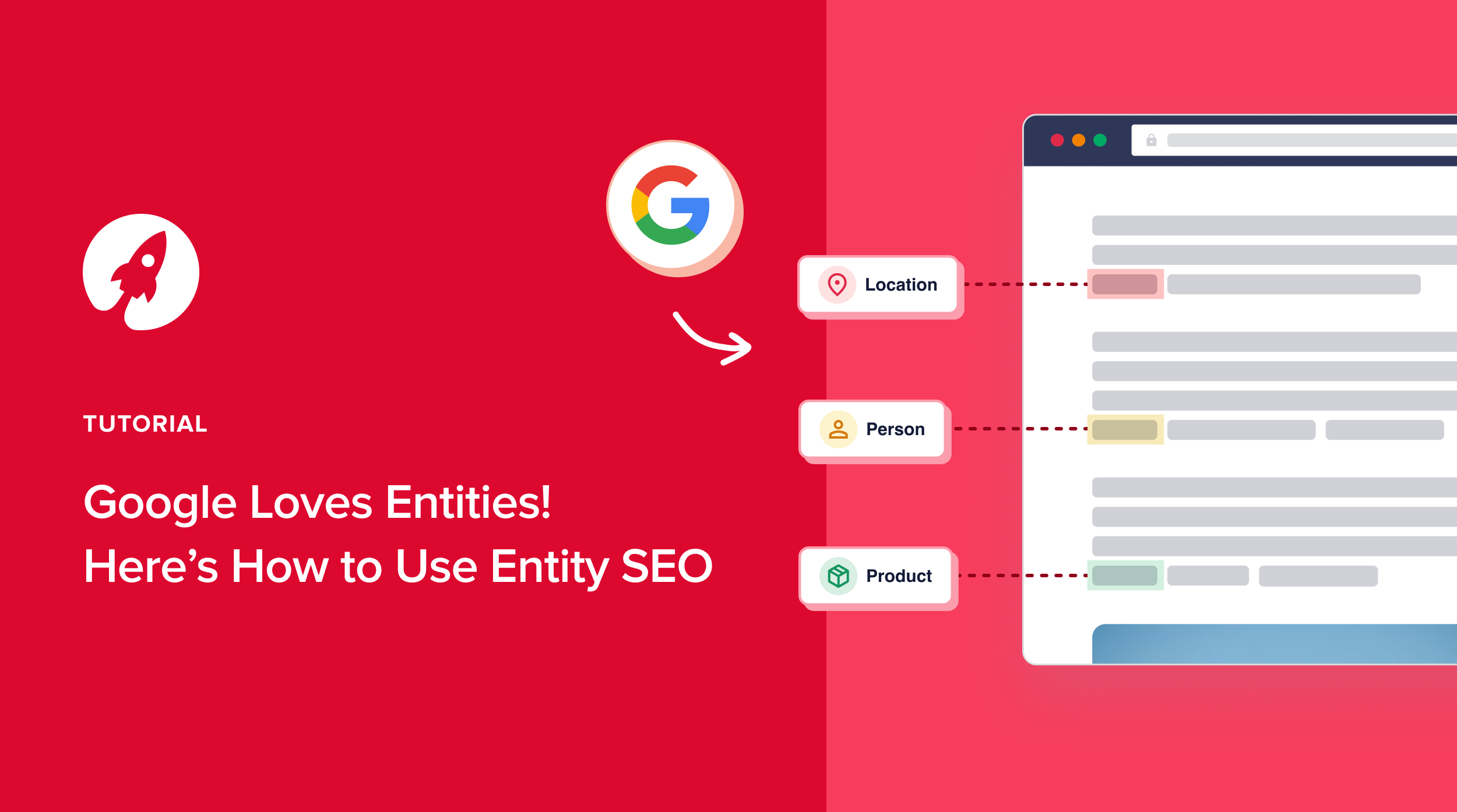If you’re serious about enhancing your brand’s search visibility, understanding entity SEO is non-negotiable.
I’ve optimized dozens of pieces using entity-based strategies, and the results consistently outperform traditional keyword-only content.
In this post, I’ll walk you through everything I’ve learned about how to use entity SEO to boost your rankings and how SEOBoost plays a critical role in making it easier.
Let’s start with a definition.
What Are Entities in SEO?
Entities are more than just keywords. They’re well-defined concepts that search engines can identify and categorize independently.
Think: people, places, brands, events, or even abstract concepts like “climate change” or “blockchain.”
The biggest difference between regular keywords and entities is context. While keywords are strings of text, entities carry meaning and relationships. When you optimize for entities, you’re speaking Google’s language.

For instance, “apple” as a keyword could refer to the fruit or the tech company. But in entity SEO, Google identifies “Apple Inc.” as a distinct entity through its Knowledge Graph.
Why Entity SEO Matters in 2025
Entity SEO helps content stand out in an increasingly context-aware algorithm. Google is shifting focus from strings (keywords) to things (entities), making semantic search and knowledge-based relationships more powerful than ever.
In content workflows, focusing on entities helps you:
- Improve topical authority by covering connected topics.
- Rank for broader variations of user queries.
- Gain visibility in rich results (like featured snippets or knowledge panels).
And the best part?
It works even if you’re not a technical SEO expert, especially when using the right SEO tools.
The Role of Google’s Knowledge Graph
Google’s Knowledge Graph is a giant web of interlinked entities. It’s how the algorithm understands that “Elon Musk,” “Tesla,” and “SpaceX” are all related.
And it’s the engine behind those knowledge panels you see on the right side of search results.
The more clearly your content aligns with how the Knowledge Graph categorizes entities, the better your visibility.
How Entity SEO Differs From Traditional SEO
Most old-school SEO strategies revolve around keyword targeting. But entity SEO shifts the focus from keyword stuffing to semantic understanding.
Here’s how I’d explain the difference:
| Traditional SEO | Entity SEO |
| Focuses on exact keywords | Focuses on concepts and context |
| Optimizes per keyword | Optimizes per topic/relationship |
| Ranking depends on the match | Ranking depends on understanding |
In practice, I’ve seen higher engagement and improved rankings by weaving entity relationships naturally into my writing, especially when paired with AI SEO tools like SEOBoost, which I’ll dive into shortly.
4 Strategies for Implementing Entity SEO
Mastering entity SEO doesn’t require reinventing your entire content workflow. It’s just about being more intentional with how you structure and support your topics.
Let’s get into the 4 core strategies I personally rely on when optimizing for entities.
1. Utilize Structured Data (Schema Markup)
One of the most effective ways to help Google “read” your content is by implementing structured data using schema markup. This is how you signal to the search engine what your page is about, explicitly.
When I’m writing a product review, recipe, article, or FAQ, I always wrap key elements in schema tags using tools like AIOSEO. It’s like giving Google a cheat sheet about your content.
You can have different schema markup based on the context of the content. For instance, if a blog focuses on how to do something, you should opt for a how-to schema markup.
This practice also helps you with rich snippets and increases your chances of getting featured.
Now, doing it manually can be time-consuming and a little difficult if you don’t have a technical background. Which is why I use AIOSEO’s Schema Generator to apply markup (especially product, article, and FAQ).
Once you’ve generated the schema markup, you can also validate it with Google’s Rich Results Test.
2. Create Comprehensive Content Around Entities
You don’t want just to mention an entity; you want to surround it with depth, relevance, and semantic relationships.
Here’s what that looks like in practice:
- Cover related topics that often appear in the same Knowledge Graph neighborhood.
- Link to authoritative sources to build trust.
- Use supporting entities naturally throughout the piece.
What this means is that when you create a guide or a blog post about a topic, try to go into as much content depth as you can to reinforce the main entity and improve contextual coverage.
This is where SEOBoost becomes my not-so-secret weapon. Its Topic Reports feature helps me discover connected and related keywords and phrases to include.
This helps me understand the hierarchy of concepts within a niche.
3. Leverage Internal Linking to Connect Related Entities
Entity SEO thrives on context and connection, and internal linking is one of the most effective ways to build those bridges across your site.
When I publish new content, I make it a priority to connect it with existing posts that mention related entities. This not only strengthens topical authority but also guides both users and search engines through a structured content journey.
The challenge, of course, is scale. If you’re managing a blog with dozens (or hundreds) of articles, finding the right internal linking opportunities can feel overwhelming.
That’s where AIOSEO’s Link Assistant becomes a game-changer.
Instead of manually combing through old posts to find relevant links, Link Assistant automatically scans your site and suggests contextual internal links that reinforce entity relevance.
This tool not only saves me hours of manual work but also ensures I never miss opportunities to strengthen entity connections.
Also, you should use descriptive anchor text (instead of generic “click here”) to reinforce semantic relationships across your site, boosting both crawlability and topical authority.
4. Optimize for Natural Language Queries
Entity SEO shines when content mirrors how people speak and search, especially as voice search continues to grow.
This means:
- Writing in a conversational tone
- Including question-based subheadings (e.g., “What is an entity in SEO?”)
- Optimizing for long-tail and contextual phrases
I use LowFruits for this as it helps me spot low-competition queries from real users in Google. I pair those insights with SEOBoost’s Content Briefs to ensure I’m still hitting key on-page elements.
How to Use SEOBoost for Entity SEO
If I had to credit one tool that transformed the way I approach SEO in 2025, it would be SEOBoost.
While most platforms focus solely on keywords or performance metrics, SEOBoost goes a step further, helping you optimize for entities, context, and content depth.
Here’s how I use it to create entity-rich content that ranks and resonates.
AI-Powered Content Optimization
Once I’ve drafted my content, I run it through SEOBoost’s Content Optimization feature, and this is where lots of ‘aha’ moments happen.
Unlike basic content editors that only flag keyword usage, SEOBoost analyzes the content with semantic depth in mind.
It combines the suggestions with the topic report created for the focus keyword. This means, you get contextual phrases to include in your content.
You also get keyword and entity placement for balance and flow.
Using this tool, you can do better keyword integration while maintaining the readability and content flow. This way, you get a better on-page SEO score for your content.
Entity Recognition and Enhancement
One of the most underrated features? SEOBoost’s ability to highlight key entities in your draft and suggest additional ones you may have missed.
To do this, you can start by uploading or pasting your draft into SEOBoost’s editor.
The tool automatically highlights relevant keyphrases and related entities to include. For instance, in an article about the best SEO tools, it’ll flag tools like SEOBoost, Semrush, or Moz to include in the content.
It also suggests other phrases that are contextually relevant.
You can review the suggestions and enrich the content where it fits naturally.
This not only helps improve topical depth but also ensures that Google’s entity-driven algorithm more easily understands the content.
Topic Reports to Plan Entity Clusters
Great content starts with great content planning.
This is why, I start with SEOBoost’s Topic Reports to map out what kind of entity network I want to build.
Let’s say I want to target “Content Strategy” as a main entity. The Topic Reports for that focus keyword would then generate 7 different types of reports that give me content ideas.
I can use the related keywords and explore relevant questions to generate related content.
I use this to plan supporting blogs or landing pages that link to each other, building a topic cluster that reinforces the central entity in Google’s eyes.
3 Common Mistakes to Avoid in Entity SEO
Let’s be honest: I’ve made my share of mistakes when trying to implement entity SEO.
Here are the ones to avoid if you want to get this right:
1. Overlooking Structured Data Implementation
If you skip schema markup, you’re missing a huge opportunity to help search engines understand your content.
Fix: Use tools like AIOSEO or Google’s Structured Data Markup Helper to tag key elements.
2. Focusing Solely on Keywords
Entity SEO is about meaning, not just matching words. Relying only on keyword frequency won’t cut it anymore.
Fix: Use tools like SEOBoost that go beyond keywords and assess entity relevance.
3. Ignoring User Intent
If your content doesn’t answer the deeper “why” behind a search, it won’t rank, even if it’s technically optimized.
This is why, it’s super important to target the right search intent.
Fix: Study the SERP and use SEOBoost’s Content Briefs to structure your content based on real user questions.
FAQs About Entity SEO
What is an entity in SEO?
An entity in SEO refers to a clearly identifiable subject such as a person, brand, place, product, or concept. Google recognizes entities as unique nodes of information that help provide context and relevance to search queries.
What is the difference between keyword and entity?
Keywords are specific words or phrases that users type into search engines. Entities, on the other hand, are recognized concepts that search engines understand even if they’re phrased differently. For example, “Nike” is an entity (and keyword), while “best Nike running shoes” is a keyword phrase (but not an entity).
How to optimize for entity SEO?
To optimize for entity SEO, use structured data to help search engines recognize entities. You should also create content that explores topics in depth and includes related entities. Focus on context, semantic relevance, and internal linking between associated topics.
Final Word
Entity SEO is no longer a future trend.
Search engines are smarter, users are more specific, and content creators need to keep up.
What changed the game for me was realizing that keywords alone aren’t enough. I needed to create content that was understood, not just crawled. That’s where tools like SEOBoost made all the difference.
So if you’re still optimizing for keywords only, it’s time to evolve. Because Google doesn’t just read your content anymore — it understands it.




